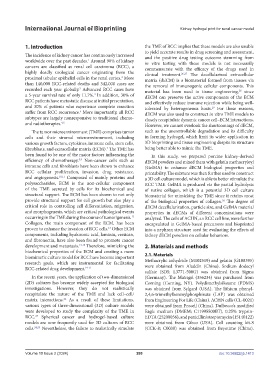Page 288 - IJB-10-2
P. 288
International Journal of Bioprinting Kidney hydrogel print for renal cancer model
1. Introduction the TME of RCC implies that these models are also unable
to yield accurate results in drug screening and assessment,
The incidence of kidney cancer has continuously increased and the positive drug testing outcome stemming from
worldwide over the past decades. Around 90% of kidney in vitro testing with these models is not necessarily
1
cancers are classified as renal cell carcinoma (RCC), a commensurate with the efficacy of the drugs used in
highly deadly urological cancer originating from the clinical treatment. 26,27 The decellularized extracellular
proximal tubular epithelial cells in the renal cortex. More matrix (dECM) is a biomaterial formed from tissues via
2
than 140,000 RCC-related deaths and 342,000 cases are the removal of immunogenic cellular components. This
recorded each year globally. Advanced RCC cases have material has been used in tissue engineering, since
3
28
a 5-year survival rate of only 11.7%. In addition, 30% of dECM can preserve the active components of the ECM
4
RCC patients have metastatic disease at initial presentation, and effectively reduce immune rejection while being well-
and 30% of patients who experience complete resection tolerated by heterogeneous hosts. For these reasons,
29
suffer from RCC recurrence. More importantly, all RCC dECM was also used to construct in vitro TME models to
5
subtypes are largely nonresponsive to traditional chemo- closely recapitulate dynamic cancer cell–ECM interactions.
and radiotherapies. However, we cannot overlook the shortcomings of dECM,
4,6
The tumor microenvironment (TME) comprises tumor such as the uncontrollable degradation and its difficulty
cells and their stromal microenvironment, including in forming hydrogel, which limit its wider application in
various growth factors, cytokines, immune cells, stem cells, 3D bioprinting and tissue engineering despite its structure
fibroblasts, and extracellular matrix (ECM). The TME has being better able to mimic the TME.
7
been found to be one of the major factors influencing the In this study, we prepared porcine kidney-derived
efficiency of chemotherapy. Non-cancer cells such as dECM powders and mixed them with gelatin methacryloyl
8,9
immune cells and fibroblasts have been shown to enhance (GelMA) to enhance dECM biological properties and
RCC cellular proliferation, invasion, drug resistance, printability. The mixture was then further used to construct
and angiogenesis. 10,11 Composed of mainly proteins and a 3D cell culture model, which is able to better stimulate the
polysaccharides, ECM is the non-cellular component RCC TME. GelMA is produced via the partial hydrolysis
of the TME secreted by cells for its biochemical and of native collagen, which is a potential 3D cell culture
structural support. The ECM has been shown to not only biomaterial for mimicking the TME since it retains most
provide structural support for cell growth but also play a of the biological properties of collagen. The degree of
30
critical role in controlling cell differentiation, migration, dECM decellularization, particle size, and GelMA material
and morphogenesis, which are critical pathological events properties in dECMs of different concentrations were
occurring in the TME during the course of tumorigenesis. analyzed. The cells of ACHN, an RCC cell line, were further
12
Collagen, the main component of the ECM, has been encapsulated in GelMA-based precursors and bioprinted
proven to enhance the invasion of RCC cells. Other ECM into a nephron structure used for evaluating the effects of
13
components, including hyaluronic acid, laminin, versican, kidney dECM powders on cellular behaviors.
and fibronectin, have also been found to promote cancer
development and metastasis. 14-18 Therefore, mimicking the 2. Materials and methods
biochemical properties of the ECM and creating a more
biomimetic culture model for RCC have become important 2.1. Materials
research goals, which are instrumental for facilitating Methacrylic anhydride (M102519) and gelatin (G108395)
RCC-related drug development. 19-21 were obtained from Aladdin (China). Sodium dodecyl
sulfate (SDS; L3771-500G) was obtained from Sigma
In the recent years, the application of two-dimensional (Germany). The Matrigel (356234) was purchased from
(2D) cultures has become widely accepted for biological Corning (Corning, NY). Polydimethylsiloxane (PDMS)
investigations. However, they do not realistically was obtained from Sylgard (USA). The lithium phenyl-
recapitulate the nature of the TME and lack cell–cell/ 2,4,6-trimethylbenzoylphosphinate (LAP) was obtained
matrix interactions. As a result of these limitations, from Engineering For Life (China). ACHN cells (CL-0021)
22
various types of three-dimensional (3D) culture models were obtained from Procell (China). Dulbecco’s modified
were developed to study the complexity of the TME in Eagle medium (DMEM; C11995500BT), 0.25% trypsin-
RCC. Spherical cancer and hydrogel-based culture EDTA (25200056), and penicillin/streptomycin (15140122)
23
models are now frequently used for 3D cultures of RCC were obtained from Gibco (USA). Cell counting kit-8
cells. 24,25 Nevertheless, the failure to realistically simulate (CCK-8; C0038) was obtained from Beyotime (China).
Volume 10 Issue 2 (2024) 280 doi: 10.36922/ijb.1413

